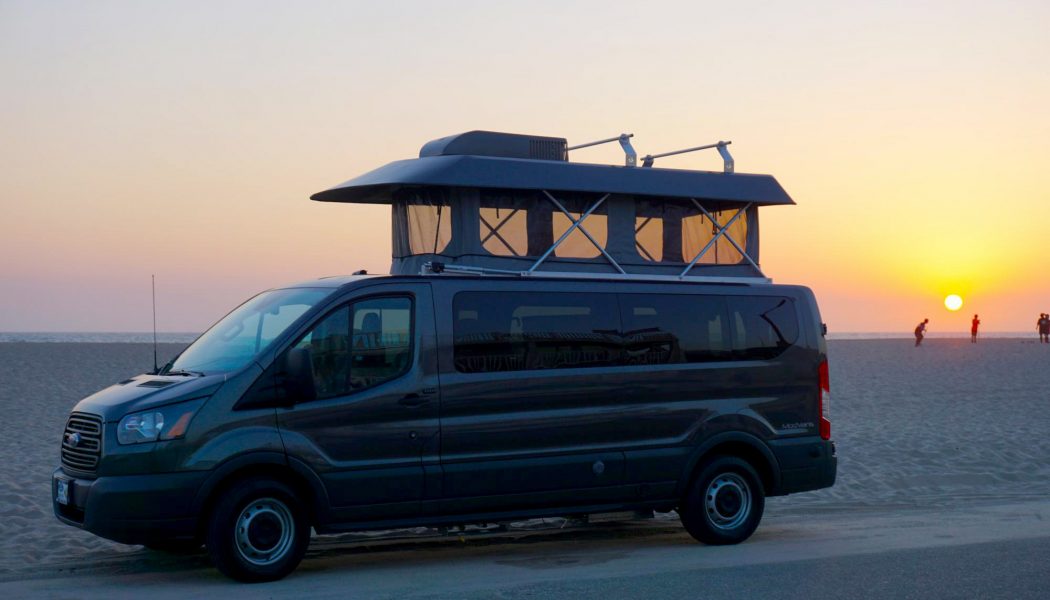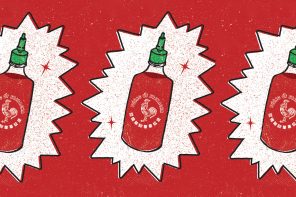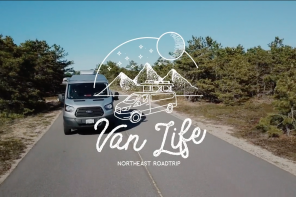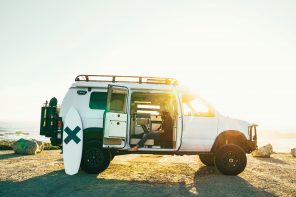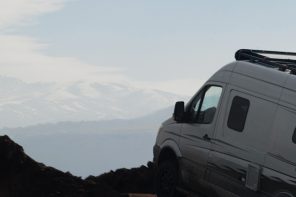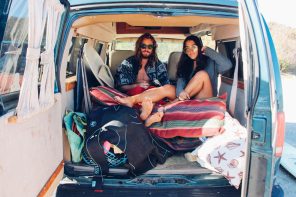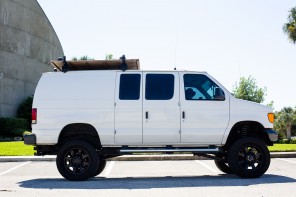A Look Inside ModVans’ Ventura Van Lab
PJ Tezza is the kind of guy who has never seen a problem that couldn’t be fixed with a couple of brackets, some clamps and a little ingenuity. He did not set out to design a better camper van. It just happened. A series of methodical systems improvements the former software engineer saw as somewhat obvious.The modular camper van PJ created, ModVans CV1, took top honors in the Van Life category at Go RVing’s The Reveal, a showcase of the newest innovations within the industry. As a van you can drive every day, haul magazines across four states, move your friend’s queen size bed and belongings crosstown, or take on a monthlong road trip with three friends, it’s garnered quite a few fans in its two years of production. We meet PJ at his nascent Ventura production studio-cum-van lab, where a van on a lift is being fitted with the aluminum rods, struts and attachments that will begin to turn it into a CV1.
PJ asks at one point if we’ve read “Barbarian Days,” William Finnegan’s Pulitzer Prize-winning memoir of a surfing life. It’s a good book, he’ll allow, and he’d recommend it, but he says he found it frustrating in parts. “How do you mean?” we ask. Well, in the book Finnegan recounts his stories of surfing around the world with his friends looking for hidden spots. Before Surfline or anything. They’re going to Cloudbreak when it was truly undiscovered. Things like that. And they keep running into trouble. Either they walk for days and don’t find the waves they are looking for, or a buddy gets malaria while bushwhacking. “And the answer’s right in front of them the whole time,” PJ says, “but they don’t see it.”
They just needed a boat.
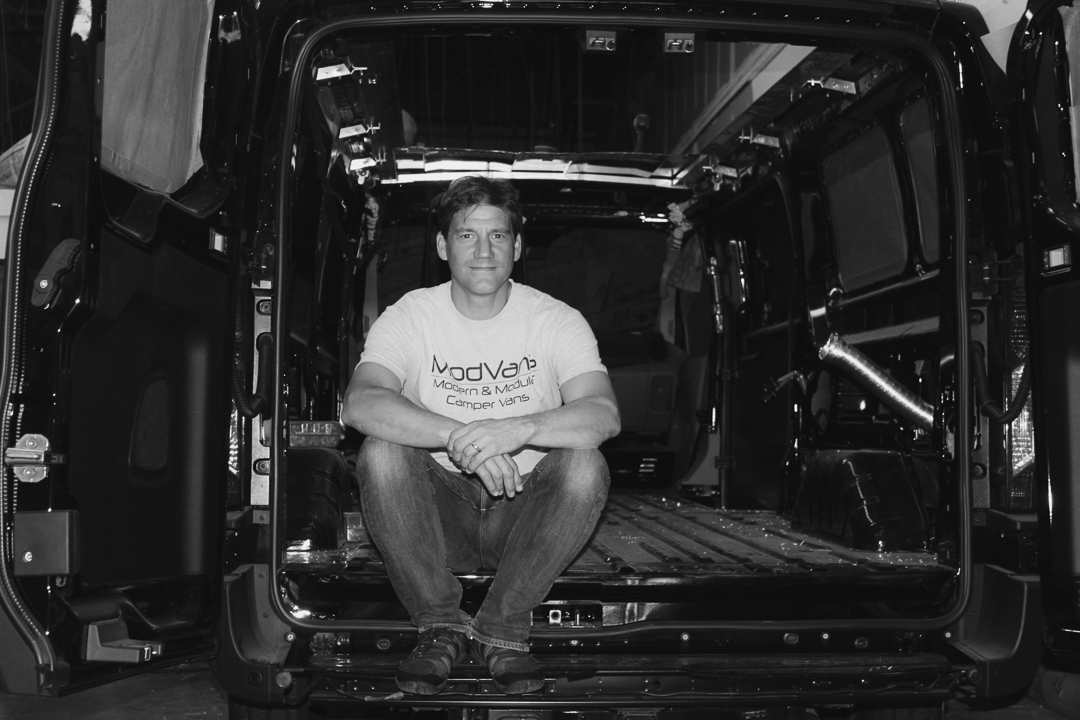
PJ at his shop in Ventura in a conversion in progress.
You’re Gonna Need a Smaller Boat
The road to the CV1, ModVans first foray into camper vans (as the name implies), began in Phoenix where PJ spent some time going back and forth from his home in Berkeley for a software engineering consulting gig at a technology center, and picked up a land yacht for a song to take long trips with his family and friends. This boat of a highway cruiser, a 26-foot class C, slept six.
“When I was in Phoenix working on this contract, I realized that Phoenix is the land of used RVs,” he says. “If you ever want to buy a used RV and give it a try, just go check out Craigslist in Phoenix.” His hobby in Phoenix, where he was away from Laurie who was home working on an MBA in California, became looking at RVs. That’s when the wheels started turning.
Looking for something that fit his needs, he found, well, not really anything.
The 26-footer he eventually ended up buying in Phoenix took him and Laurie and and their two dogs to Yellowstone, the Tetons and Yosemite. After he retrofitted it with seatbelts enough for an eight-person road trip. But after a couple of adventures in the RV, it became a bit of a problem to store back home in Berkeley. And he didn’t really need all that space for the smaller trips he and Laurie usually took, so he sold it, but immediately started planning what he wanted for the next one.
He did the research you might expect of someone who had spent most of the last three decades as a Silicon Valley engineer. Looking for something that fit his needs, he found, well, not really anything. “That was how I ended up building one for myself,” he says.
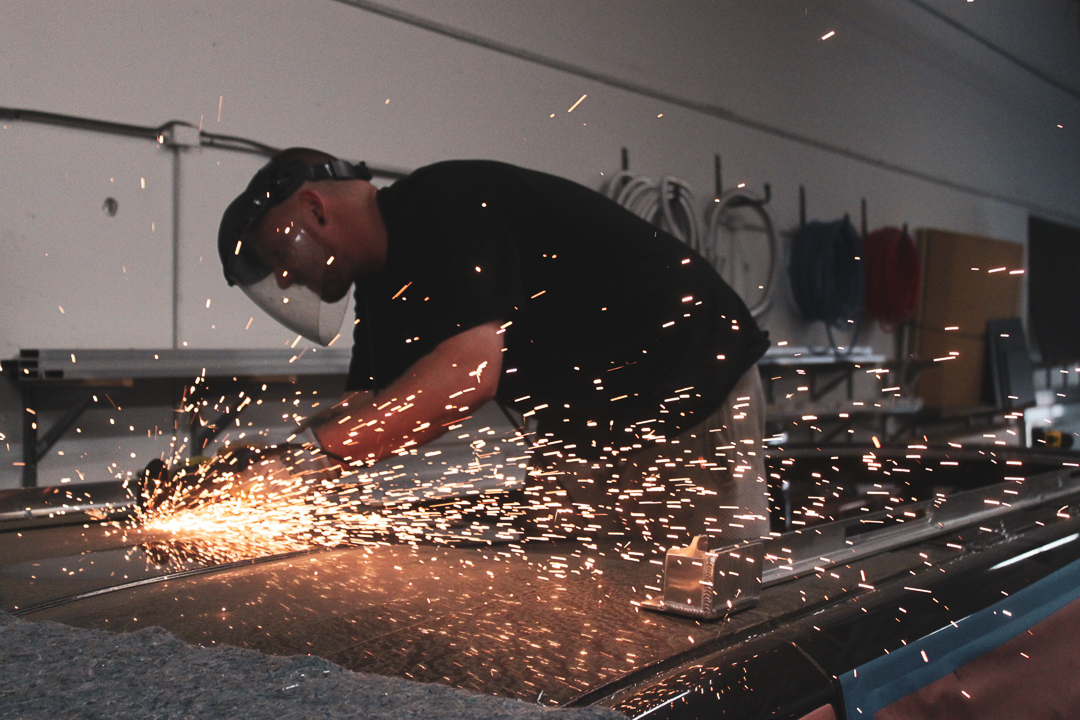
Mike “Burly” Burleson prepping a Transit for its pop-top.
Garage Days
He landed on the Ford Transit, a van that has been produced in Europe for decades but only recently came to North America when it replaced the Econoline in 2015, for the base. “I’m driving every weekend from Berkeley to Tahoe, he explains. “It’s three hours, a lot of times it’s windy, there’s snow on the ground, so I really wanted something that drove well, and most people were building on the Mercedes Sprinter or the Promaster and the full-size vans, and the Transit just drove better than those two vehicles.” That’s when a problem arose. “I had done all this research and I was like, this is the engine I want with the twin-turbo gas engine, picked all the pieces out, but there was no off the shelf RV you could buy that was built on the Transit,” he explains.
The Transit’s twin-turbo EcoBoost is a direct injection engine. “So it’s just small, lightweight, really powerful,” he explains. “And that’s one of the things I like about it. I like the super modern drive trains.”
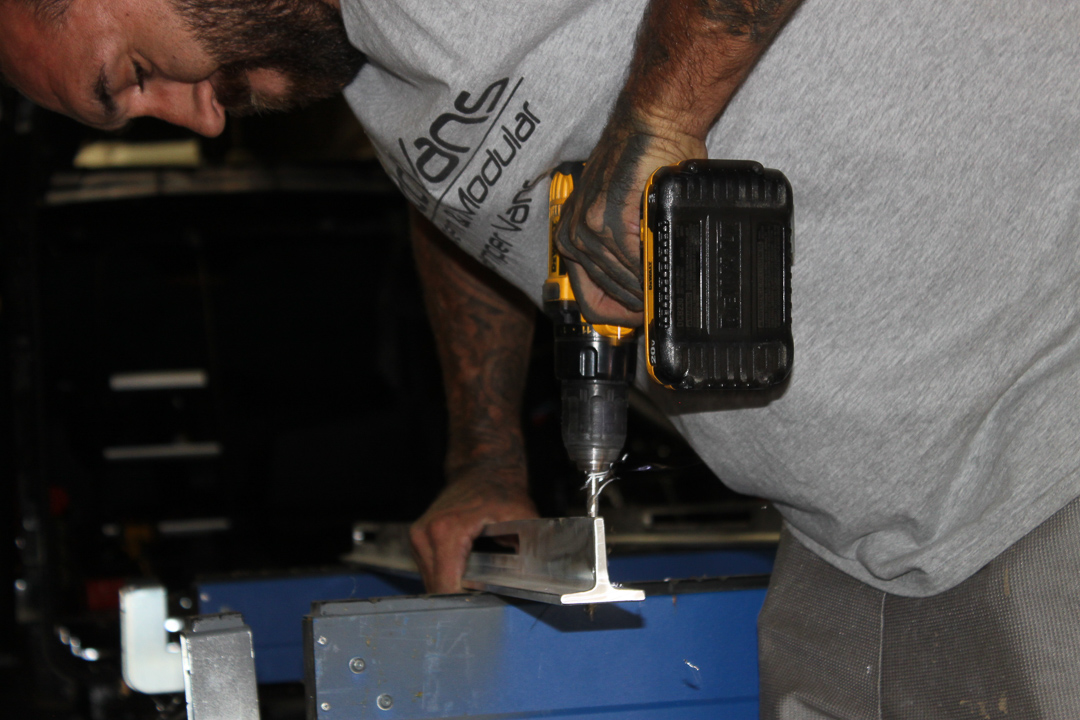
Chris Kirksey readying the struts for the roof.
He bought the first model year of Transit that year, 2015, and even found somebody to do a custom van conversion, but the wait was more than a year. He’s still working as a software consultant but has these long breaks between gigs. “I was just looking at this big silver van in my driveway,” he says. And he thought, I have some hand tools. Little by little, the van started to change. First, he put in a second row of comfy seats, then a bed. He’d long had an idea for aluminum-angle cabinets. Not necessarily in a van but, as it turned out, there was a van in his driveway in need of cabinets. PJ says, “I was like, okay, I’ll go buy some aluminum from the distributor and get it in. I bought a miter saw, because I didn’t really have that many tools there even, and just doing it all totally in the driveway. They turned out to be super strong and lightweight, kind of like I had always imagined.”
He’d long had an idea for aluminum-angle cabinets. Not necessarily in a van but, as it turned out, there was a van in his driveway in need of cabinets.
The layout and the design, functional at this point, but still had some of the modern and retro-future industrial look he likes, were just for him. And little things that have come to define what ModVans are, came about just through the process of building that first van in his driveway. “When I was building the cabinets out of aluminum, which that came first, the idea to design out of aluminum first, but then when I’m anchoring these things down, they’re so light and strong, they could easily be taken out,” he says. “I was like, ‘I think I could just put these in with fasteners that would make it easy to take in and out.’”
“That happened as an artifact of the construction technique I had chosen for the cabinets. And then also, the seats were able to unclip, so all that happened. Then we had one experience where we were helping my daughter move, and I took the cabinets out and I was able to fit her queen-sized mattress. You’re like, I don’t know if I’ll ever even use that functionality. It’s there, and we put it in there, but then we actually used it and were like, ‘Oh yeah, that’s pretty handy.’”
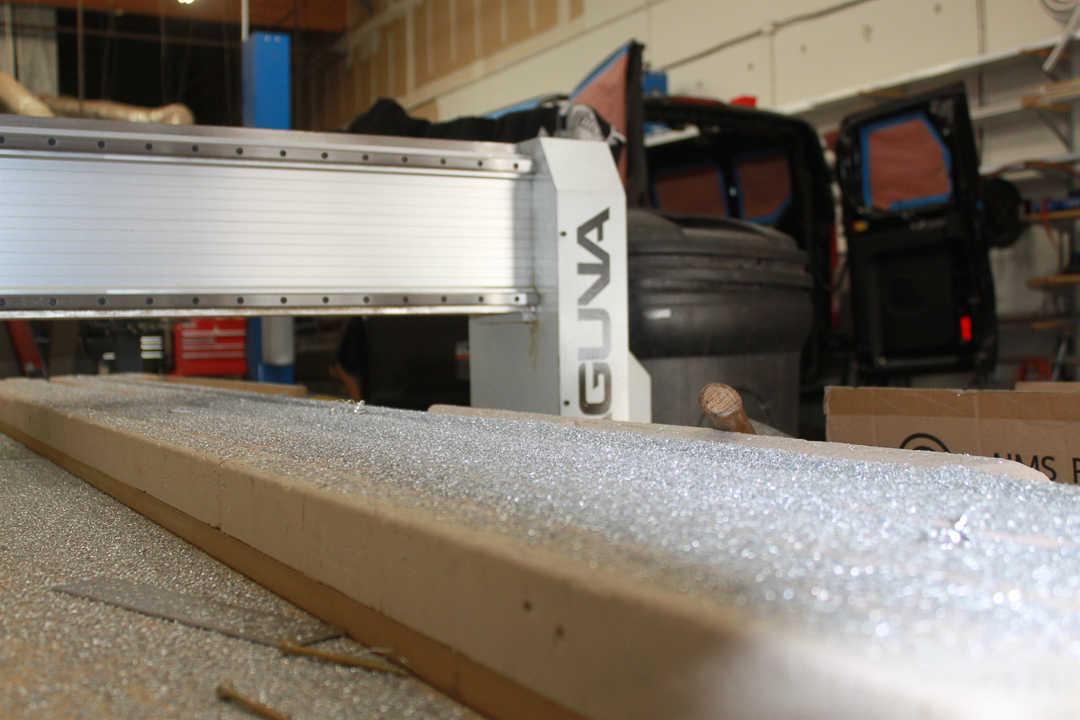
Aluminum dust on one of the CNCs.
Then as he drove the Transit he’d made in front of his house, with it’s modular detachable furniture and pop-top, people would stop and ask, “Hey, where’d you get this thing? How can I get one?” PJ says, “And my friends at the time were like, ‘Oh, you should sell these.’ And I was like, ‘No, no, no. Pretty busy with this consulting.’” Then fast forward a year to 2017 and PJ and Laurie move south to Ventura and they thought, maybe it’s time to see if there’s a market for this thing he’d made.
As a software engineer, the first thing he did was build a website with photos of his Transit. He called it Camper Van 1, or CV1, ran a couple of ads promoting it and said, “Let’s see what happens next.”
What happened next was enough people gave him deposits on preorders that he went into production. He rented space, bought equipment, hired a small crew then ran one ad and pre-sold 10 CV1s in two months. “I turned it all off and I haven’t turned it on since,” he says.
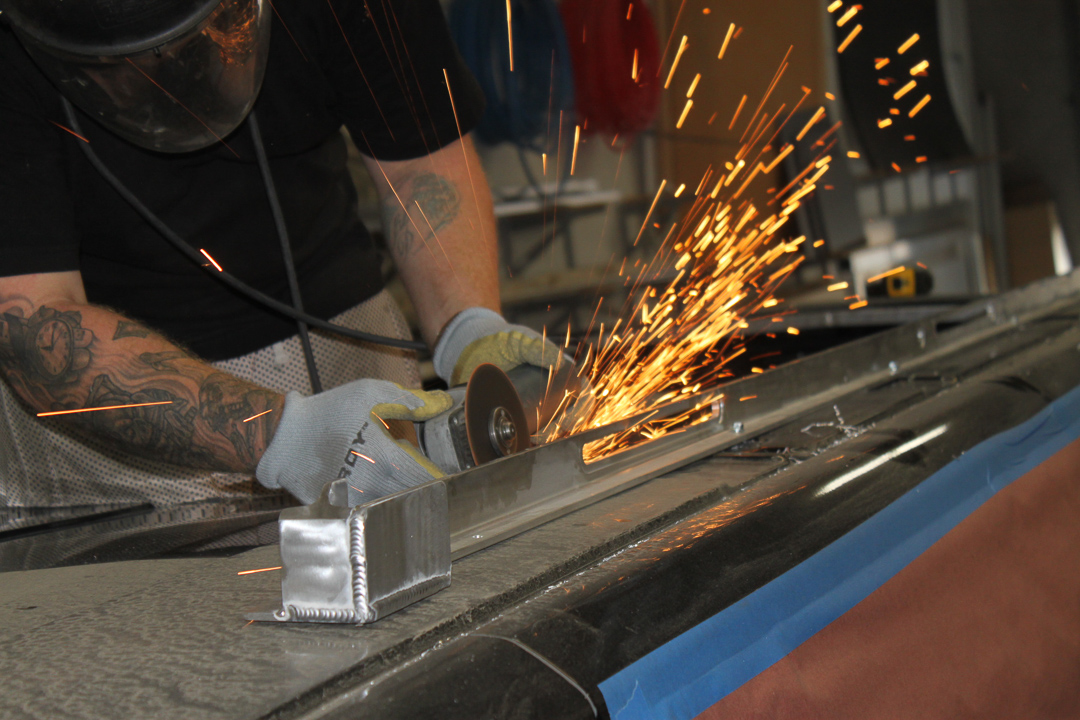
Cutting away the roof to install the CV1’s pop-top.
The production facility in Ventura is relatively modest but it’s been a proving ground for PJ’s systems and modifications as he tinkers with the best and most efficient ways to produce ModVans.
Most of the parts that go into the CV1 are now made in-house, cut with a CNC or molded there or nearby (such as the pop-top cover, the foam-core-between-fiberglass construction of which would be familiar to anyone who’s ever seen a surfboard). To make the modular fixtures fully removable, PJ came up with a system to put the furnace concealed in the chassis covered by aluminum cut by a CNC that folds into a box-like origami.
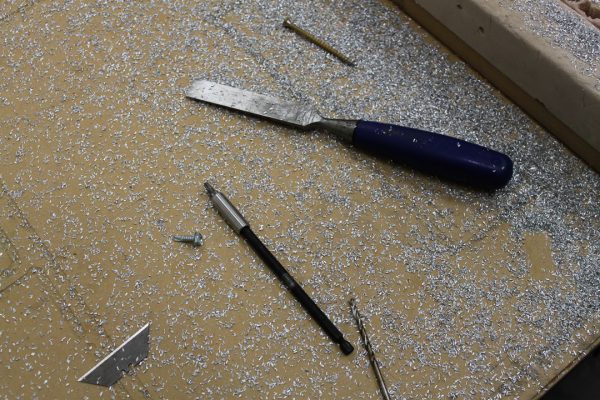
The Road Ahead
“Right now we’re just getting really good at building CV1. That’s our main goal because we cannot build those anywhere near fast enough. Even if we built 10 a month, that’s not fast enough. A hundred a month, probably not fast enough,” PJ says.
So ModVans is looking for investors to grow the production, now that the systems have been fine-tuned.
Looking further ahead, PJ says it’s looking at the fact that maybe a gasoline-powered vehicle isn’t the future of campers. And then after that? “If I could design a vehicle that could look like whatever I wanted it to, would it look like a van? Would it start off looking like a van? And my answer is no, probably not.” he says. “It’d look like something else. So if I could just start with, ‘I just need four wheels, that’s all I’ve got to have.’ What would it look like?”

